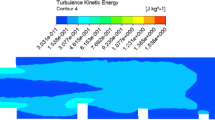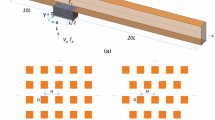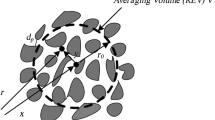Abstract
The objective of this work is to study the numerical modeling of turbulent flow in a compound hydraulic scheme. The configuration adopted to collect the water flows from the inputs of several other secondary channels is typical. Indeed, this model is almost a real representation of the existing hydraulic structure, to study the spatio-temporal dynamics of unsteady turbulent flows. In addition, the work also consists of implementing an appropriate turbulence model, to ensure a better analysis of free, homogeneous isotropic turbulent flows. To test relevance and validity of the hypotheses on the behavior of turbulent flows in a complex hydraulic system such as ours and to corroborate the results obtained, we have compelled to compare the numerical results carried out with the experimental results of the work having demonstrated a great interest for turbulent flows and having been conducted under identical conditions (Jiménez and Hanif J Hydraul Eng 114:377–395, 1988; Fennema and Chaudhry J Hydraul Eng 116:1013–1034, 1990; Bhallamudi and Chaudhry J Hydraul Res 30:77–93, 1992). Particular emphasis is placed on the geometry of the digital channel adopted as well as other parameters such as roughness and channel slope, to identify fluctuations in hydrodynamic parameters and the distribution of turbulent stresses and wall friction. The equations governing the phenomenon studied are directly related to the continuity and momentum conservation equations which form the system of nonlinear Navier–Stokes equations. The modeling by numerical simulations based on finite volumes was carried out using the Fluent software, which is a 3D numerical model, using the system of nonlinear partial differential equations of the movement of fluids in a continuous medium




















Similar content being viewed by others
References
Bhallamudi SM, Chaudhry MH (1992) Computation of flow in open-channel transitions. J Hydraul Res 30(1):77–93
Cadot O (2013) Introduction à la turbulence. France, ENSTA-ParisTech, p 30
Champagne FH, Harris VG, Corsin S (1970) Experiments on nearly homogeneous turbulent shear flow. J Fluid Mech 41(1):81–139
Chang P (2008) Modélisation des écoulements turbulents a surface libre par éléments finis de frontière
Chassaing P (2000) Turbulence en mécanique des fluides, analyse du phénomène en vue de sa modélisation à l’usage de l’ingénieur, Polytech, ed. CEPADUES 1:625
Chassaing P (2000) Turbulence en mécanique des fluides. Cépaduès-Editions
Chou PY (1945) On velocity correlations and the solutions of the equations of turbulent fluctuation. Q Appl Math 3(1):38–54
da Silva EG (2007) Méthodes et analyse numériques. Engineering school Institut Polytechnique de Grenoble
Deissler RG (1976) Derivation of the Navier-Stokes equation (for teachers). Am J Phys 44(2):1128–1130
Erpicum S (2006) Optimisation objective de paramètres en écoulements turbulents a surface libre sur maillage multibloc. Université de Liège, Belgique
Fennema RJ, Chaudhry MH (1990) Explicit methods for 2-D transient free surface flows. J Hydraul Eng 116(8):1013–1034
Irving SH (2003) Fluid mechanics, livre, 4th edn. McGraw-Hill Book Co, p 814
Jiménez OF, Hanif CM (1988) Computation of supercritical free-surface flows. J Hydraul Eng 114(4):377–395
Kolmogorov AN (1941) Equations of turbulent motion in an incompressible fluid. Dokl Akad Nauk SSSR 30:299–303
Lesieur M (1994) La turbulence. Presses universitaires de Grenoble, p 262
Lesieur M (1997) Turbulence in fluids. Kluwer Academic Publishers
Lesieur M (2014) Turbulence, 2013th edn. EDP sciences
Molls T, Chaudhry MH (1995) Depth-averaged open-channel flow, model. J Hydraul Eng 121(6):453–465
Patankar S (1980) Numerical heat transfer and fluid flow. CRC Press
Rose WG (1966) Results of an attempt to generate a homogeneous turbulent shear flow. J Fluid Mech 25(1):97–120
Ruelle D, Takens F (1971) On the nature of turbulence. Les Rencontres Physiciens-Mathématiciens De Strasbourg-RCP25 12:1–44
Author information
Authors and Affiliations
Corresponding author
Additional information
Publisher's Note
Springer Nature remains neutral with regard to jurisdictional claims in published maps and institutional affiliations.
Rights and permissions
About this article
Cite this article
Khanfouf, O., Ali, F. Numerical modeling of isothermal homogeneous turbulent flows by finite volumes in a compound hydraulic scheme. Model. Earth Syst. Environ. 8, 1911–1921 (2022). https://doi.org/10.1007/s40808-021-01196-3
Received:
Accepted:
Published:
Issue Date:
DOI: https://doi.org/10.1007/s40808-021-01196-3




